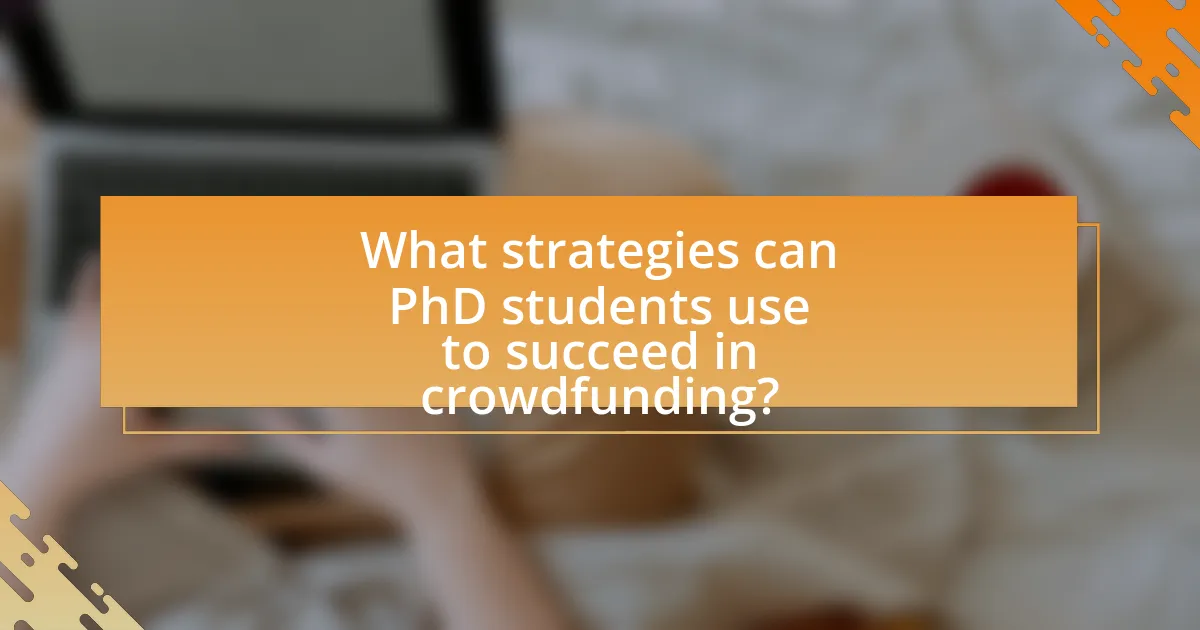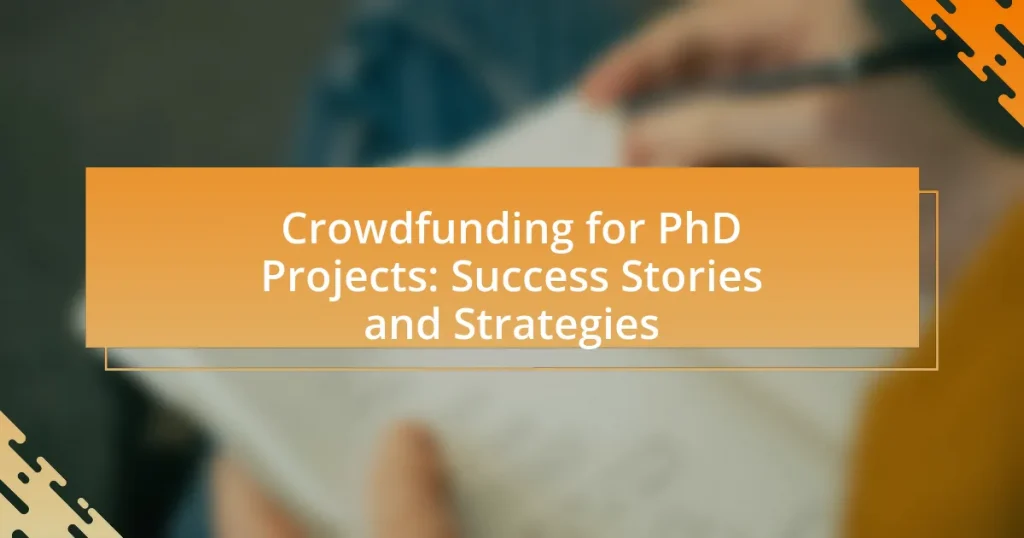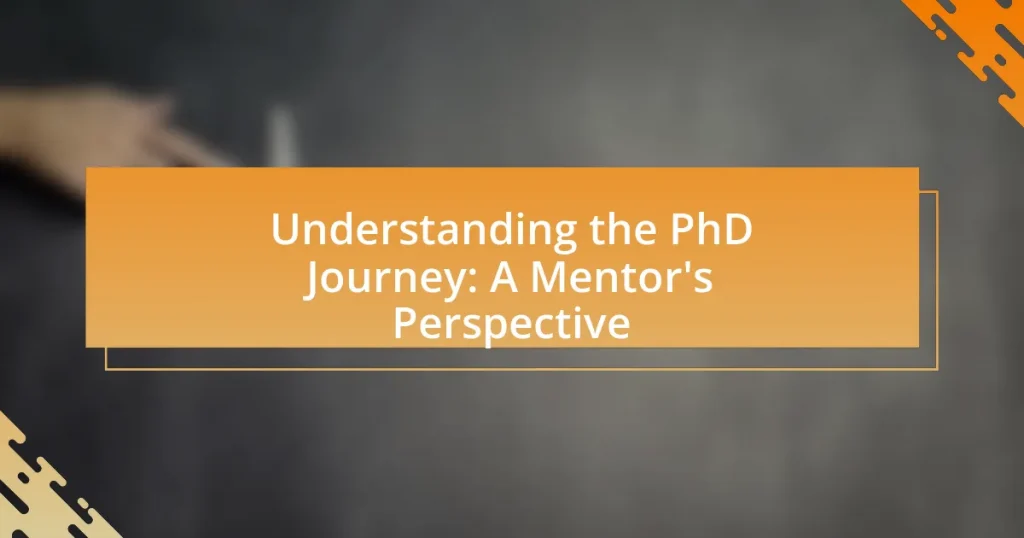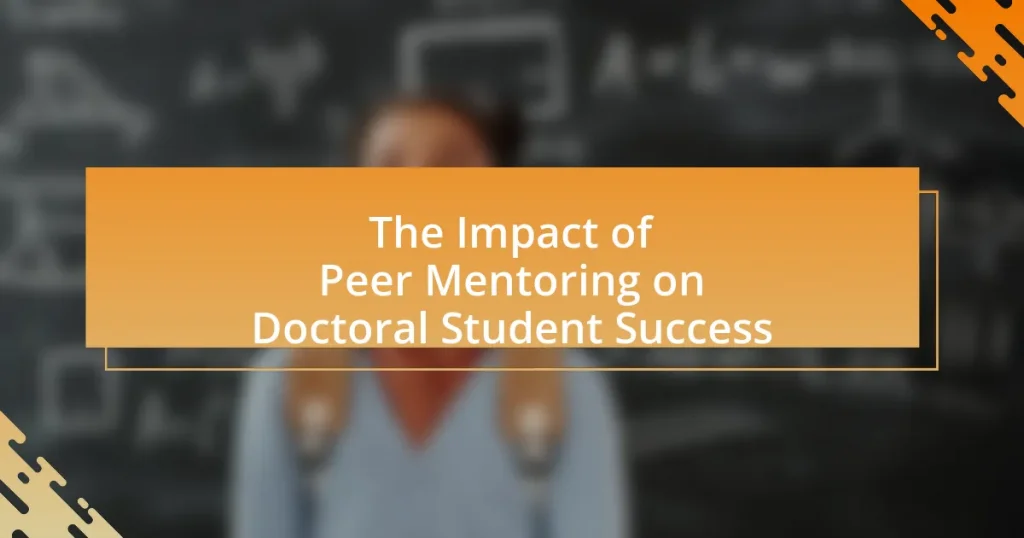Crowdfunding for PhD projects is an innovative funding method that allows doctoral candidates to raise money for their research through small contributions from a large audience, primarily via online platforms like Kickstarter and Indiegogo. This article explores how crowdfunding works in academia, the various platforms available, typical funding goals, and the advantages it offers over traditional funding sources. It highlights successful crowdfunding campaigns, effective marketing strategies, and best practices for PhD students to enhance their chances of success. Additionally, the article addresses common challenges faced by students and provides practical tips for maintaining momentum throughout their campaigns.

What is Crowdfunding for PhD Projects?
Crowdfunding for PhD projects is a method of raising funds through small contributions from a large number of people, typically via online platforms. This approach allows PhD candidates to finance their research, covering expenses such as materials, travel, and living costs. According to a study published in the Journal of Business Research, crowdfunding has gained popularity in academia, with platforms like Kickstarter and Indiegogo enabling researchers to connect with potential backers who are interested in supporting innovative projects.
How does crowdfunding work for academic research?
Crowdfunding for academic research involves soliciting small contributions from a large number of people, typically via online platforms, to fund specific research projects. Researchers create campaigns that outline their project goals, methodologies, and funding needs, often including incentives for backers, such as updates or acknowledgments. Platforms like Kickstarter and Indiegogo facilitate these campaigns, allowing researchers to reach a global audience. Successful campaigns often leverage social media and personal networks to generate interest and support, with some projects raising thousands of dollars. For instance, a study by the University of Cambridge found that academic crowdfunding can significantly enhance funding opportunities, with projects that effectively communicate their impact attracting more backers.
What platforms are available for crowdfunding PhD projects?
Platforms available for crowdfunding PhD projects include Kickstarter, Indiegogo, GoFundMe, and Experiment.com. Kickstarter and Indiegogo are popular for creative and innovative projects, while GoFundMe is often used for personal fundraising, including educational expenses. Experiment.com specifically caters to scientific research and academic projects, allowing researchers to present their work and seek funding directly from the public. Each platform has unique features that can support PhD candidates in securing financial backing for their research initiatives.
What are the typical funding goals for PhD crowdfunding campaigns?
Typical funding goals for PhD crowdfunding campaigns range from $1,000 to $50,000, depending on the project’s scope and requirements. Many campaigns aim for around $5,000 to $10,000 to cover specific research expenses such as materials, travel, and conference fees. According to a study published in the Journal of Business Research, successful campaigns often set clear, achievable funding targets that align with their project needs, enhancing their chances of reaching their goals.
Why is crowdfunding a viable option for PhD students?
Crowdfunding is a viable option for PhD students because it provides an alternative funding source that can alleviate financial burdens associated with research and tuition. Many PhD students face challenges securing traditional funding, such as grants or scholarships, which can be highly competitive and limited in availability. Crowdfunding platforms allow students to present their research projects directly to the public, enabling them to raise funds from individuals who are interested in supporting academic endeavors. For instance, a study by the University of Cambridge found that successful crowdfunding campaigns for academic projects often exceed their funding goals by engaging a community of supporters who are passionate about the research topic. This model not only helps in securing necessary funds but also fosters a sense of community and engagement around the research, making crowdfunding an effective strategy for PhD students.
What are the advantages of crowdfunding over traditional funding sources?
Crowdfunding offers several advantages over traditional funding sources, primarily accessibility, speed, and community engagement. Unlike traditional funding, which often requires extensive networks and lengthy application processes, crowdfunding platforms allow individuals to present their projects directly to a global audience, significantly lowering barriers to entry. For instance, a study by Massolution in 2015 reported that crowdfunding raised over $34 billion globally, demonstrating its growing popularity and effectiveness. Additionally, crowdfunding can provide funds much faster than traditional grants, which may take months or even years to secure. This rapid funding process enables researchers to initiate their projects promptly. Furthermore, crowdfunding fosters community engagement, as backers often feel a personal connection to the projects they support, leading to a more invested and supportive network.
How does crowdfunding enhance community engagement in research?
Crowdfunding enhances community engagement in research by allowing researchers to directly involve the public in funding and supporting their projects. This participatory approach fosters a sense of ownership among community members, as they contribute financially and often engage in discussions about the research goals and outcomes. For instance, a study published in the journal “Research Policy” found that projects funded through crowdfunding platforms often receive feedback and input from backers, which can shape the research direction and increase its relevance to the community. Additionally, crowdfunding campaigns can raise awareness about specific research topics, mobilizing community interest and support, thereby creating a collaborative environment that benefits both researchers and the public.

What are some successful crowdfunding campaigns for PhD projects?
Some successful crowdfunding campaigns for PhD projects include the “PhD in a Box” initiative, which raised over $10,000 to support students in completing their dissertations, and the “The Science of Happiness” project, which garnered $15,000 to fund research on well-being. These campaigns demonstrate effective strategies such as clear communication of project goals and engaging storytelling, which resonate with potential backers. Additionally, platforms like Kickstarter and Indiegogo have hosted numerous successful campaigns, showcasing the viability of crowdfunding for academic research.
What factors contributed to the success of these campaigns?
The success of crowdfunding campaigns for PhD projects is primarily attributed to effective communication strategies. Clear articulation of project goals and the significance of the research engages potential backers, as evidenced by campaigns that provide detailed descriptions and compelling narratives about their work. Additionally, leveraging social media platforms to reach wider audiences enhances visibility, with studies showing that campaigns promoted through social networks often exceed funding targets by significant margins. Furthermore, establishing a strong personal connection with potential supporters fosters trust and encourages contributions, as demonstrated by successful campaigns that include personal stories and updates throughout the funding process.
How did effective marketing strategies play a role?
Effective marketing strategies significantly enhanced the success of crowdfunding campaigns for PhD projects by increasing visibility and engagement. For instance, targeted social media advertising allowed researchers to reach specific demographics interested in their fields, resulting in higher funding rates. A study by the University of Pennsylvania found that campaigns with strong marketing components raised 50% more funds than those without. This demonstrates that effective marketing not only attracts backers but also builds a community around the project, fostering ongoing support and collaboration.
What unique project ideas attracted backers?
Unique project ideas that attracted backers in the context of crowdfunding for PhD projects include innovative research on sustainable energy solutions, such as solar panel technology improvements, and interdisciplinary studies combining art and science, like using virtual reality to enhance educational experiences. These projects garnered support due to their potential for significant societal impact and the ability to address pressing global challenges. For instance, a project focused on developing affordable solar energy systems raised over $100,000 on a crowdfunding platform, demonstrating strong interest and backing for practical, eco-friendly innovations.
What lessons can be learned from these success stories?
Success stories in crowdfunding for PhD projects demonstrate the importance of clear communication and community engagement. Successful campaigns often highlight the need for a compelling narrative that resonates with potential backers, as evidenced by projects that effectively articulate their research goals and societal impact. Additionally, these stories reveal that building a strong network prior to launching a campaign can significantly enhance funding outcomes, as seen in cases where researchers leveraged existing academic and social connections to mobilize support. Furthermore, the use of rewards and incentives tailored to backers’ interests has proven effective in motivating contributions, as illustrated by projects that offered unique experiences or tangible outcomes related to their research.
What common mistakes should be avoided in crowdfunding campaigns?
Common mistakes to avoid in crowdfunding campaigns include inadequate planning, lack of a clear value proposition, and insufficient marketing efforts. Inadequate planning can lead to unrealistic funding goals and poorly defined project timelines, which often result in campaign failure. A lack of a clear value proposition makes it difficult for potential backers to understand the project’s significance, reducing their motivation to contribute. Insufficient marketing efforts can prevent the campaign from reaching a wider audience, limiting funding opportunities. According to a study by the University of Pennsylvania, campaigns that effectively communicate their goals and engage with their audience are 50% more likely to succeed.
How can storytelling improve the chances of success?
Storytelling can significantly improve the chances of success in crowdfunding for PhD projects by creating an emotional connection with potential backers. When researchers articulate their journey, challenges, and aspirations through compelling narratives, they engage audiences on a personal level, making the project more relatable and memorable. Studies indicate that campaigns with strong storytelling elements can raise up to 300% more funds than those without, as emotional engagement drives higher levels of support. This connection not only fosters trust but also encourages sharing, amplifying the project’s reach and visibility.

What strategies can PhD students use to succeed in crowdfunding?
PhD students can succeed in crowdfunding by clearly defining their project goals, effectively communicating their research’s impact, and leveraging social media for outreach. Clearly defined goals help potential backers understand the purpose and significance of the project, increasing their willingness to contribute. Effective communication of the research’s impact, including how it addresses real-world problems or contributes to knowledge, can resonate with potential supporters. Additionally, utilizing social media platforms can expand the reach of the crowdfunding campaign, allowing students to connect with a broader audience and engage potential donors. Research indicates that campaigns with strong storytelling and clear objectives tend to attract more funding, highlighting the importance of these strategies in achieving crowdfunding success.
How can PhD students effectively promote their campaigns?
PhD students can effectively promote their campaigns by leveraging social media platforms, engaging with academic communities, and utilizing targeted outreach strategies. Social media allows for broad dissemination of campaign messages, enabling students to reach potential backers and supporters quickly. Engaging with academic communities, such as university networks and research groups, fosters credibility and encourages word-of-mouth promotion. Targeted outreach, including personalized emails to potential donors and collaboration with influencers in relevant fields, can significantly enhance visibility and support for the campaign. Research indicates that campaigns with strong social media presence and community engagement tend to achieve higher funding success rates, demonstrating the effectiveness of these promotional strategies.
What role does social media play in crowdfunding success?
Social media significantly enhances crowdfunding success by increasing visibility and engagement with potential backers. Platforms like Facebook, Twitter, and Instagram allow project creators to share their campaigns widely, reaching diverse audiences quickly. Research indicates that campaigns promoted on social media can raise up to 50% more funds than those that are not. Additionally, social media facilitates community building, enabling creators to connect with supporters, share updates, and foster a sense of involvement, which can lead to higher funding rates.
How can networking enhance funding opportunities?
Networking enhances funding opportunities by connecting individuals with potential investors, collaborators, and mentors who can provide financial support. Through networking, researchers can share their project ideas, gain insights, and build relationships that may lead to funding sources such as grants, sponsorships, or crowdfunding platforms. For instance, a study by the National Science Foundation found that 70% of successful grant applicants had strong professional networks, highlighting the importance of connections in securing funding.
What are the best practices for creating a compelling crowdfunding campaign?
The best practices for creating a compelling crowdfunding campaign include crafting a clear and engaging narrative, setting realistic funding goals, and utilizing high-quality visuals. A clear narrative helps potential backers understand the project’s purpose and impact, while realistic funding goals ensure that the campaign is achievable, which can increase trust among supporters. High-quality visuals, such as videos and images, enhance the campaign’s appeal and can significantly boost engagement. According to a study by Indiegogo, campaigns with videos raise 9% more funds than those without, highlighting the importance of visual content in attracting backers.
How important is setting a realistic funding goal?
Setting a realistic funding goal is crucial for the success of crowdfunding campaigns, particularly for PhD projects. A well-defined funding goal aligns with the project’s actual financial needs, which increases the likelihood of reaching that target. Research indicates that campaigns with realistic goals are 30% more likely to succeed compared to those with overly ambitious targets. This is because achievable goals foster trust among potential backers, encouraging them to contribute. Additionally, realistic goals help in effectively communicating the project’s value and scope, making it easier to engage with the audience and secure necessary funds.
What elements should be included in a campaign video?
A campaign video should include a clear message, compelling visuals, a personal story, a call to action, and relevant background information. The clear message articulates the purpose of the campaign, while compelling visuals capture attention and maintain viewer interest. A personal story connects emotionally with the audience, making the campaign relatable. The call to action directs viewers on how to support the campaign, and relevant background information provides context about the project, enhancing credibility. These elements are essential for effectively engaging potential supporters and increasing the likelihood of funding success in crowdfunding for PhD projects.
What common challenges do PhD students face in crowdfunding?
PhD students commonly face challenges in crowdfunding, including limited networks, lack of marketing skills, and difficulty in articulating their research impact. Limited networks hinder their ability to reach potential backers, as many rely on personal connections for funding. Additionally, many PhD students lack the marketing expertise necessary to create compelling campaigns that attract attention and funding. Furthermore, articulating the significance and potential impact of their research in a way that resonates with a broader audience can be challenging, often leading to ineffective communication of their project’s value. These challenges are supported by studies indicating that successful crowdfunding campaigns often depend on strong social networks and effective communication strategies.
How can students overcome skepticism from potential backers?
Students can overcome skepticism from potential backers by presenting a well-researched and compelling project proposal that clearly outlines the project’s objectives, methodology, and potential impact. A detailed budget and timeline can enhance credibility, as they demonstrate careful planning and transparency. Additionally, showcasing previous successes or endorsements from credible figures in the field can further validate the project. According to a study by the University of Pennsylvania, projects that include a clear narrative and demonstrate social proof are 30% more likely to receive funding. This evidence supports the effectiveness of a structured approach in addressing potential backers’ concerns.
What strategies can help maintain momentum throughout the campaign?
To maintain momentum throughout a crowdfunding campaign for PhD projects, consistent communication with backers is essential. Regular updates about project progress, milestones achieved, and upcoming goals keep supporters engaged and invested. Research indicates that campaigns with frequent updates can increase funding by up to 50%, as backers feel more connected and informed about the project’s journey. Additionally, leveraging social media to share successes and encourage sharing among networks amplifies reach and visibility, further sustaining momentum.
What practical tips can enhance crowdfunding efforts for PhD projects?
To enhance crowdfunding efforts for PhD projects, researchers should focus on creating a compelling narrative that clearly articulates the project’s significance and impact. A well-structured campaign that includes a personal story, detailed project goals, and a clear budget can significantly increase engagement and funding. Additionally, leveraging social media platforms to reach a broader audience and actively engaging with potential backers through updates and personal interactions can foster a sense of community and support. Research indicates that campaigns with engaging videos and visuals tend to attract more backers, as they effectively convey the project’s essence and urgency.



